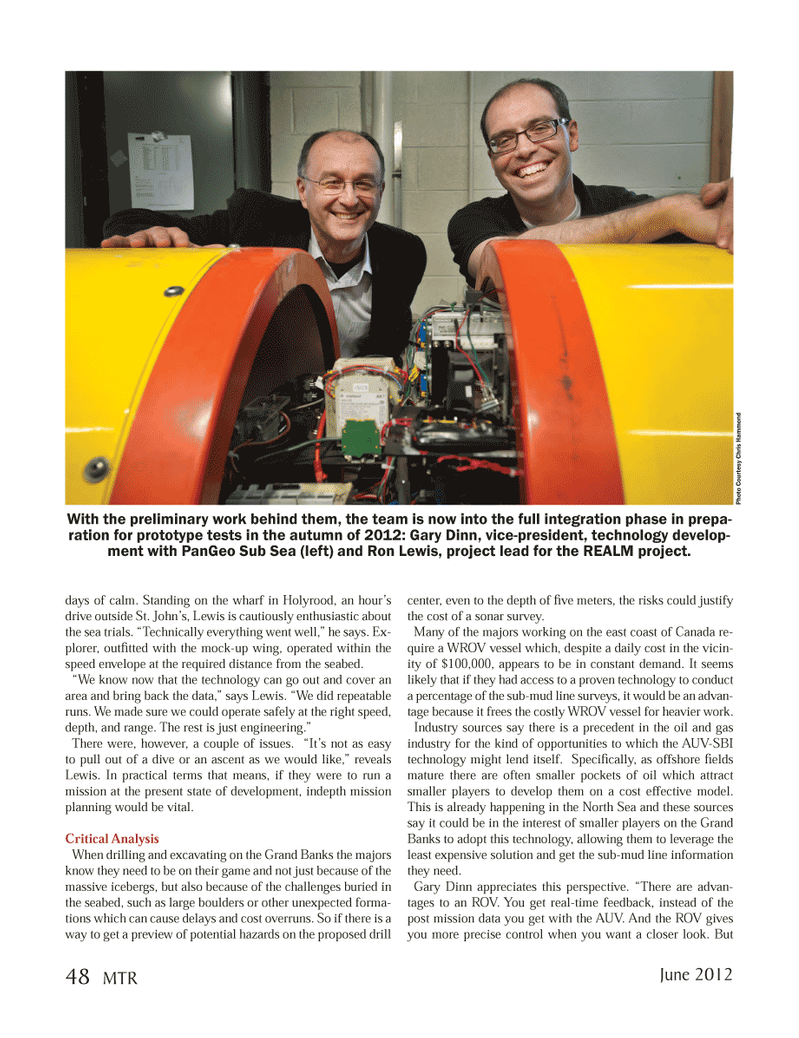
Page 48: of Marine Technology Magazine (June 2012)
AUV Arctic Operations
Read this page in Pdf, Flash or Html5 edition of June 2012 Marine Technology Magazine
days of calm. Standing on the wharf in Holyrood, an hour?s drive outside St. John?s, Lewis is cautiously enthusiastic about the sea trials. ?Technically everything went well,? he says. Ex- plorer, out tted with the mock-up wing, operated within the speed envelope at the required distance from the seabed. ?We know now that the technology can go out and cover an area and bring back the data,? says Lewis. ?We did repeatable runs. We made sure we could operate safely at the right speed, depth, and range. The rest is just engineering.? There were, however, a couple of issues. ?It?s not as easy to pull out of a dive or an ascent as we would like,? reveals Lewis. In practical terms that means, if they were to run a mission at the present state of development, indepth mission planning would be vital. Critical AnalysisWhen drilling and excavating on the Grand Banks the majors know they need to be on their game and not just because of the massive icebergs, but also because of the challenges buried in the seabed, such as large boulders or other unexpected forma- tions which can cause delays and cost overruns. So if there is a way to get a preview of potential hazards on the proposed drill center, even to the depth of ve meters, the risks could justify the cost of a sonar survey. Many of the majors working on the east coast of Canada re- quire a WROV vessel which, despite a daily cost in the vicin- ity of $100,000, appears to be in constant demand. It seems likely that if they had access to a proven technology to conduct a percentage of the sub-mud line surveys, it would be an advan- tage because it frees the costly WROV vessel for heavier work. Industry sources say there is a precedent in the oil and gas industry for the kind of opportunities to which the AUV-SBI technology might lend itself. Speci cally, as offshore elds mature there are often smaller pockets of oil which attract smaller players to develop them on a cost effective model. This is already happening in the North Sea and these sources say it could be in the interest of smaller players on the Grand Banks to adopt this technology, allowing them to leverage the least expensive solution and get the sub-mud line information they need. Gary Dinn appreciates this perspective. ?There are advan- tages to an ROV. You get real-time feedback, instead of the post mission data you get with the AUV. And the ROV gives you more precise control when you want a closer look. But With the preliminary work behind them, the team is now into the full integration phase in prepa- ration for prototype tests in the autumn of 2012: Gary Dinn, vice-president, technology develop- ment with PanGeo Sub Sea (left) and Ron Lewis, project lead for the REALM project. Photo Courtesy Chris Hammond June 201248 MTRMTR #5 (34-49).indd 48MTR #5 (34-49).indd 485/31/2012 10:30:57 AM5/31/2012 10:30:57 AM

 47
47

 49
49
